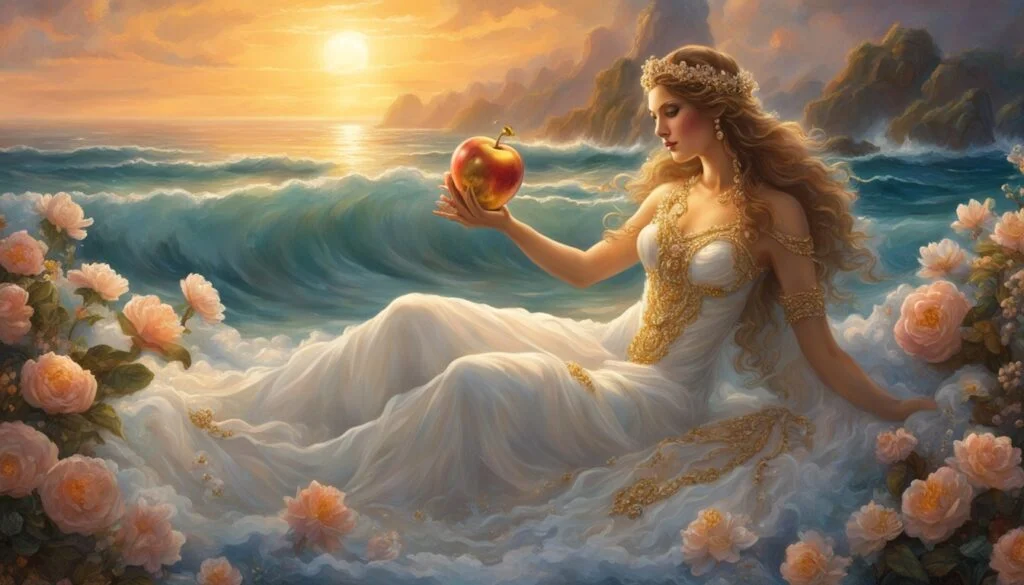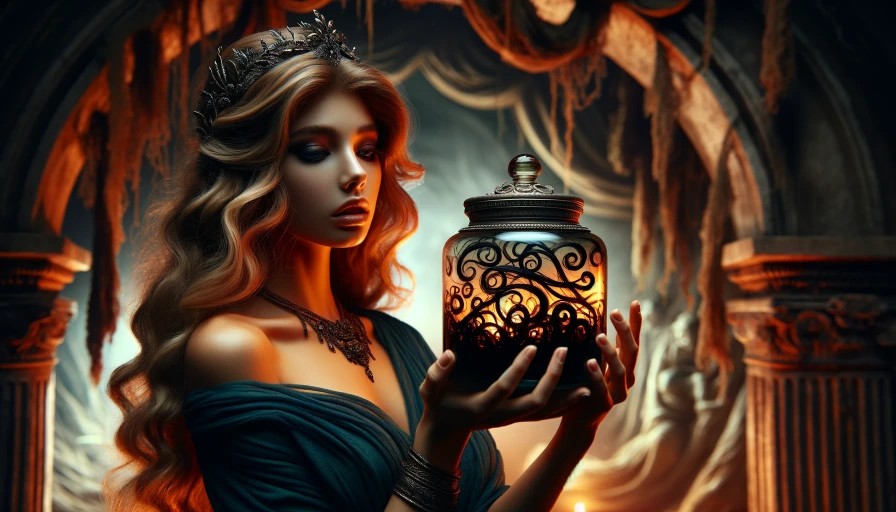In ancient Greek times, Aphrodite was known as a charming figure. She is the goddess of love, beauty, and passion.
Her reach goes well beyond love, including fertility, the sea, and even war. For centuries, Aphrodite’s beauty and charm have captivated people, making her a favorite in Greek mythology.
The story behind Aphrodite’s origins is mysterious. Some tales say she is a daughter of Zeus.
Others suggest she predates him. Her name, from “aphros” meaning sea foam in Greek, connects to a birth story where she arose from the sea.
The worship of Aphrodite was both Greek and from Near Eastern cultures.
In Greek mythology, Aphrodite’s influence was powerful. She could stir love in anyone, including other gods. This led to the start of the Trojan War.
Despite having a husband, Hephaestus, she had numerous lovers. Her son, Eros or Cupid in Roman myths, shared her ability to influence love.
Key Takeaways
- Aphrodite was the Greek goddess of love, beauty, and fertility
- Her origins are debated, with multiple birth stories in mythology
- Aphrodite had significant influence over both gods and mortals
- She played a key role in starting the Trojan War
- Aphrodite’s symbols include doves, roses, and seashells
- She was one of the twelve major Olympian gods in Greek religion
Who Was Aphrodite in Greek Mythology
Aphrodite was the Greek goddess known for love, beauty, and fertility.
There are debates on how she came to be, with two stories of her birth. Her important role in Greek myths and connection to various gods and goddesses are fascinating to learn about.
Origins and Birth
Aphrodite’s birth is a mysterious and marvelous story. Some believe she was born from sea foam when Uranus’s parts hit the sea.
Others say she’s the daughter of Zeus and Dione. She’s linked to Cyprus, where she had her first steps.
This made Cyprus a major center for her worship.
Role in the Greek Pantheon
In Greek religion, Aphrodite was crucial. She governed love, passion, and beauty. Both gods and humans felt her power.
Every year, the Aphrodisia festival was held to honor her. In Sparta, she was also seen as a war goddess, showing her diverse abilities.
Aphrodite’s Family Connections
Aphrodite was part of a large family. She married Hephaestus but loved several others.
Her children with Ares were important figures in myths:
- Eros, god of love
- Phobos, embodiment of fear
- Harmonia, goddess of harmony
She also had human lovers. One of them was Anchises, with whom she had Aeneas. He became a renowned hero in both Greek and Roman tales.
Her relationships show her impact on different stories in mythology.
The Symbolism and Attributes of Aphrodite
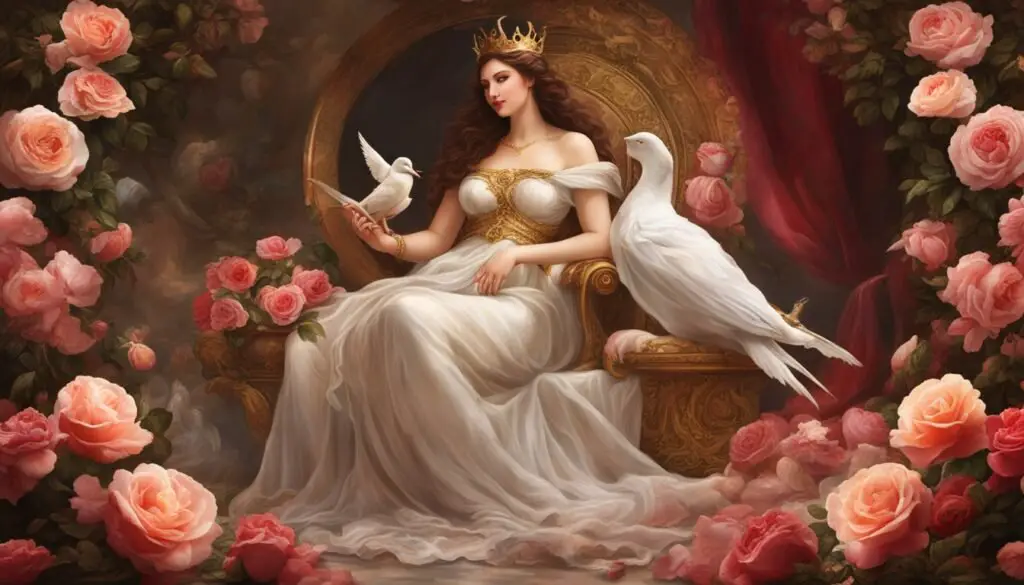
Aphrodite is more than just a Greek goddess. She’s the emblem of love, beauty, and passion. These symbols help us understand her divine nature better.
A special symbol of Aphrodite is the white dove. It means love, peace, and spiritual connections. Seashells are also important.
They show how she was born from sea foam and her power of love’s transformations.
Plants are key in understanding Aphrodite:
- Roses: They symbolize passion and desire
- Myrtles: Stand for love and femininity
- Apples: Represent beauty and temptation
Another key symbol for the Aphrodite is her magical girdle. It made her super attractive, to both gods and humans.
She’s also linked with a mirror, showing her beauty, and a cockle shell, as a reminder of her sea beginnings.
In artworks, Aphrodite is often naked or in fine clothes. She is shown with doves, swans, or in a chariot pulled by doves.
These images show her as the goddess of love, beauty, and fertility in Greek myths.
Aphrodite’s Relationships with Gods and Mortals
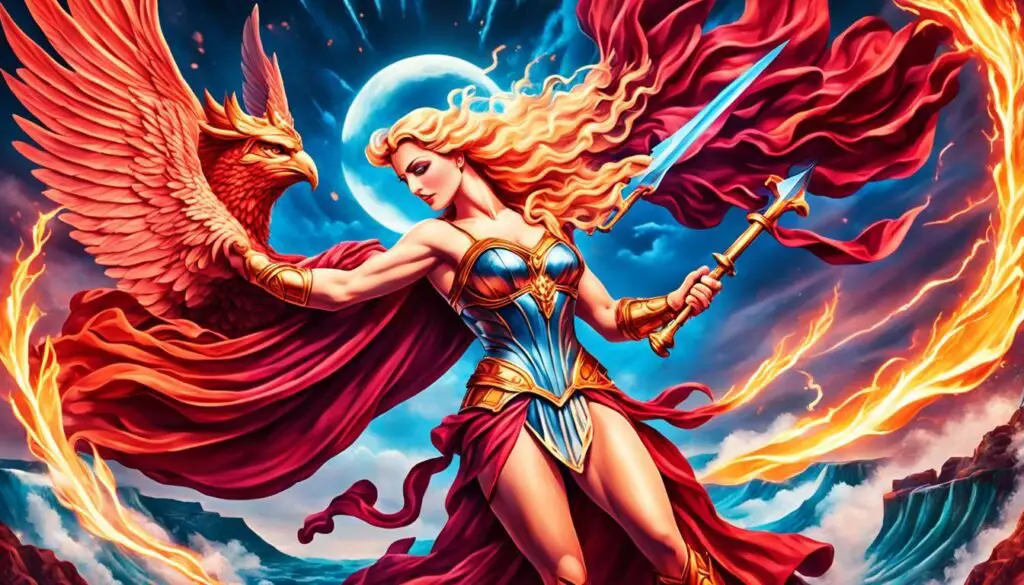
In Greek mythology, the gods and goddesses often had tricky relationships. Aphrodite, the goddess of love and beauty, knew much about this.
She had love stories that involved both gods and humans.
Marriage to Hephaestus
Aphrodite was married to Hephaestus by Zeus. This arranged marriage helped free Hera from a throne.
But despite this, Aphrodite didn’t find happiness in this union.
Affair with Ares
Her affair with Ares, the god of war, was famous. They had children together, like Eros, the god of love.
The story of Hephaestus catching them in the act is a known myth.
Mortal Lovers
She also loved mortals. With Anchises, she had Aeneas who became a hero. And Adonis, a handsome man, was another love of hers.
She grieved deeply over his death.
Aphrodite’s relationships, whether with gods or humans, made her a key part of Greek myths.
Her many loves and children showed her important place in Greek mythology.
Aphrodite’s Role in the Trojan War
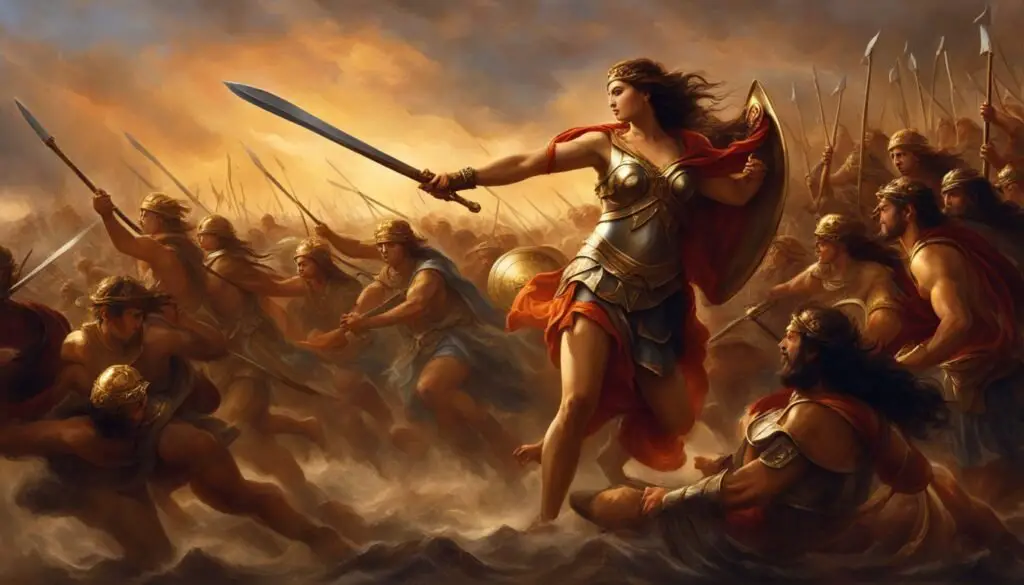
Aphrodite was central to the mythology of the Trojan War. She showed how powerful she was in ancient Greek religion.
The goddess of love started the war by promising Paris the most beautiful woman, Helen, who was already married.
Paris picked Aphrodite as the most beautiful among Hera and Athena. In return, she helped him run away with Helen.
This choice brought upon the long war on Troy.
During the war, Aphrodite kept helping the Trojans. She rescued Paris when he was about to be killed by Menelaus.
She also talked Ares into supporting the Trojans.
Aphrodite’s role demonstrates her varied abilities. She’s not only about love and beauty but affects even the biggest wars.
Her involvement in this story shows the deep link between love, beauty, and war in ancient Greek myths.
Worship and Cult Centers of Aphrodite
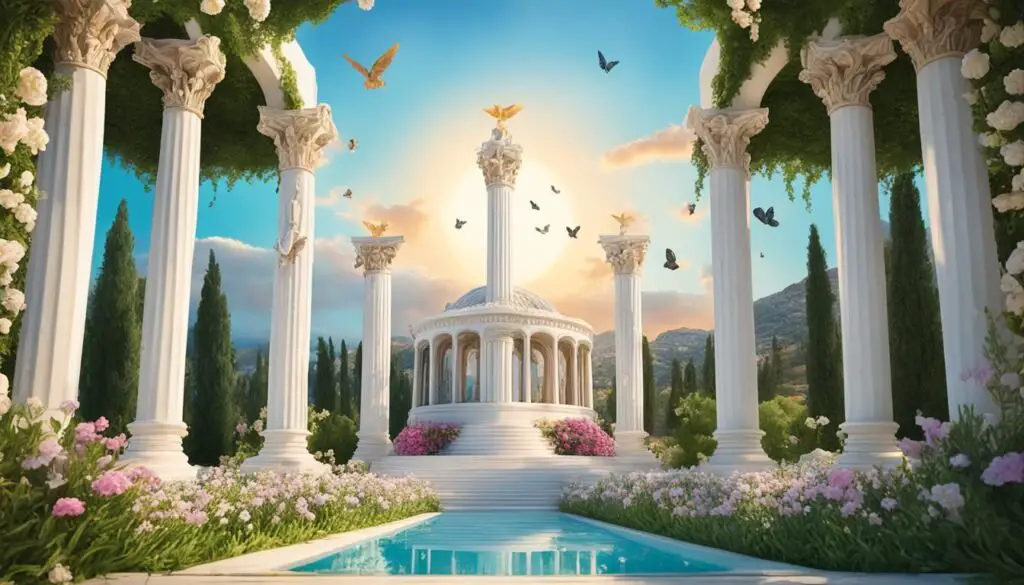
In ancient Greek religion, Aphrodite was very important. Her worship spread all over the Mediterranean.
Many big temples and sites were built for her.
Major Temples and Sanctuaries
Aphrodite’s main focus was in Cyprus, especially Paphos. Other key places were Amathus, Cythera, and Corinth.
In Athens, there were special places for her, such as Aphrodite Ourania and Aphrodite Pandemos.
The Aphrodisia Festival
People celebrated the Aphrodisia festival in the middle of summer. It was a time to honor Aphrodite with serious rituals and gifts.
Even though Aphrodite was about love, her worship was very serious.
Aphrodite as a Warrior Goddess
In Sparta, Aphrodite was seen as a warrior god. This shows how complex ancient Greek religion was.
It teaches us that Aphrodite was about more than just love and beauty.
Over time, people mixed their local beliefs with the broader Greek ideas. In Cyprus, they knew Aphrodite as Anassa and Ourania.
Her worship included things like special gardens, helping with farming, and links to royal families.
Representations of Aphrodite in Ancient Greek Art
Aphrodite was a central figure in Greek mythology. She was very popular in ancient Greek artwork. As time passed, her image changed.
These changes showed how art and culture shifted in ancient Greece.
In early art, Aphrodite was dressed and had no unique features. Then, around the 5th century BCE, things changed.
An artist named Praxiteles sculpted her in a new full-scale format. This was the first time a female nude was made in Greek art.
- The Mixing Vessel with Adonis, Aphrodite, and Persephone (390-380 B.C.) by Meleager Painter
- The “Heyl Aphrodite” figurine (200-100 B.C.)
- The Head of Aphrodite, or “The Bartlett Head” (330-300 B.C.)
- Statuette of Aphrodite Leaning on a Pillar (250-200 B.C.)
Aphrodite was often shown with symbols like seashells and pearls. These artworks often had her nude.
This highlighted her beauty and her being the goddess of love. Today, artists still use ancient Greek art to understand Aphrodite.
Aphrodite’s Influence on Roman Culture and Religion
The Greek goddess Aphrodite greatly influenced Roman culture. The Romans named her Venus and honored her.
Thus, their views on love and beauty were shaped by Aphrodite’s merged traits and stories.
Syncretism with Venus
Romans considered Venus as Aphrodite from their own mythology. She symbolized love, beauty, and new beginnings.
In Roman society, Venus became quite important. She was even believed to protect the Roman state.
Aphrodite in Roman Literature
Roman writers like Ovid and Virgil often wrote about Venus. For example, in the “Aeneid,” Venus helps Aeneas escape Troy to later build Rome.
Ovid’s “Metamorphoses” shares multiple Venus myths. These stories ensured that Greek influence remained strong in Roman culture.
In Rome, Venus was celebrated as the mother of their nation. Art portrayed her as beautiful yet powerful.
Leaders saw her as their family guardian, enhancing her place in Roman society and faith.
The Evolution of Aphrodite’s Image Through History
Aphrodite’s look changed a lot over the years. At first, she was portrayed as someone who helped with making things grow in the Near East.
She was covered from head to toe in early pictures. But as time went on, she appeared naked. This change showed shifting thoughts about beauty.
The tales of love and beauty surrounding Aphrodite traveled far and wide.
Her story began outside Greece but soon combined with the legends of local goddesses.
This mix gave birth to the Aphrodite that we recognize today.
Who was Aphrodite in Greek mythology? She was a figure filled with depth. She was seen as both being in the heavens and among people.
And she had power over areas like love, marriage, and birth. Even sailors prayed to her for safe travels.
In time, Aphrodite became connected with different symbols. Doves, swans, apples, and roses were thought to be hers.
Her oldest temple in Cyprus goes back to 1200 BC. In Roman culture, she was known as Venus. But even today, she influences art, writing, and some people still worship her.
Modern Interpretations and Cultural Impact of Aphrodite
Aphrodite, the Greek goddess of love, still captivates us today. She goes beyond ancient stories, influencing how we see love, beauty, and femininity.
Artists, writers, and those on spiritual quests find inspiration in her. This keeps her spirit alive in the current world.
Aphrodite in Literature and Pop Culture
The goddess of love, Aphrodite, appears in many modern stories. She is in books, movies, and on TV.
Her character often stands for empowerment and relationship complexity. From romance to fantasy, she adapts to today’s values, making her timeless.
Neopagan Worship of Aphrodite
Aphrodite’s worship is coming back in neopaganism. Wicca and Hellenismos are spiritual practices that honor her.
The Church of Aphrodite, created in the 20th century, worships her alone. These groups highlight love, beauty, and fertility in their rituals.
This revival shows the real impact of Greek myth. Aphrodite’s influence can be seen in every day life. From beauty products to how we see love, she’s still a big part of culture.
As we keep exploring love and beauty, Aphrodite stays a key inspiration.
Conclusion
Aphrodite is a captivating figure in Greek mythology. Her story has been told for centuries. Originating from the Near East, she became central in Greek and Roman myths.
In Greek mythology, Aphrodite was the goddess of love, beauty, and desire. She also had aspects of war and vengeance. Her complex personality adds depth to her character.
Aphrodite’s impact isn’t limited to ancient times. Her image is on modern Cyprus passports. Her festivals draw tourists to Paphos.
Countless pieces of art are inspired by her, including the Venus de Milo.
This goddess is remembered in literature, pop culture, and neopaganism. Aphrodite remains relevant today, thanks to her multifaceted nature.
She represents both divine love and relatable qualities.
Her story includes relationships with deities and humans. These tales show us the complexity of love and desire.
From her sea foam birth to her part in the Trojan War, Aphrodite’s myths are timeless.
They remind us of love and beauty’s enduring power in our lives.
FAQ
What was Aphrodite’s role in Greek mythology?
Aphrodite was the Greek goddess of love, beauty, and fertility. She was big in the Greek stories, linking to love, lust, and the beauty of people, plus making babies.
What were Aphrodite’s origins according to mythology?
Different stories explain Aphrodite’s birth in Greek myths. One tale says she rose from sea foam after Uranus lost his private parts. Another credits Zeus and Dione as her parents in the Iliad.
What were some of Aphrodite’s symbols and attributes?
Her symbols included seashells, myrtles, and roses. Birds like doves and sparrows, plus swans, were also linked to her. She had a special girdle making her extremely attractive. Eros, the Graces, and the Horae were her close friends.
Who were Aphrodite’s significant relationships with other gods and mortals?
She was wed to Hephaestus but loved Ares the most. Her affairs with mortals included Anchises, Aeneas’s dad, and Adonis. Adonis was a youth she grieved deeply for when he died.
How was Aphrodite involved in the Trojan War?
She triggered the Trojan War’s events by choosing Paris. She fought for the Trojans, mainly for Paris and her son, Aeneas, in the Iliad.
Where were Aphrodite’s main cult centers and how was she worshipped?
She was mainly worshipped in Paphos and Amathus in Cyprus. Also, on the islands of Cythera and in Corinth on mainland Greece. People celebrated her in the Aphrodisia festival each midsummer. Some saw her as a goddess of war too.
How was Aphrodite represented in ancient Greek art?
At first, artists showed her covered up in clothes. By the 5th century BCE, she got detailed and was the first woman widely shown naked. This change marked a new era in Greek art.
What was Aphrodite’s influence on Roman culture and religion?
Romans saw Aphrodite as their own Venus, blending their qualities and stories. She brought love, beauty, and fertility into Roman beliefs and culture.
How has Aphrodite’s image and significance evolved over time?
Aphrodite started as a fertility goddess in the Near East. She grew into a powerful figure in Greek myths. Her image changed from fully clothed to more open, showing how views on her role shifted.”
How is Aphrodite interpreted and worshipped in modern times?
Today, Aphrodite appears in all kinds of modern culture, showing love and beauty. People still worship her in neopagan beliefs, honoring her as a major goddess.


